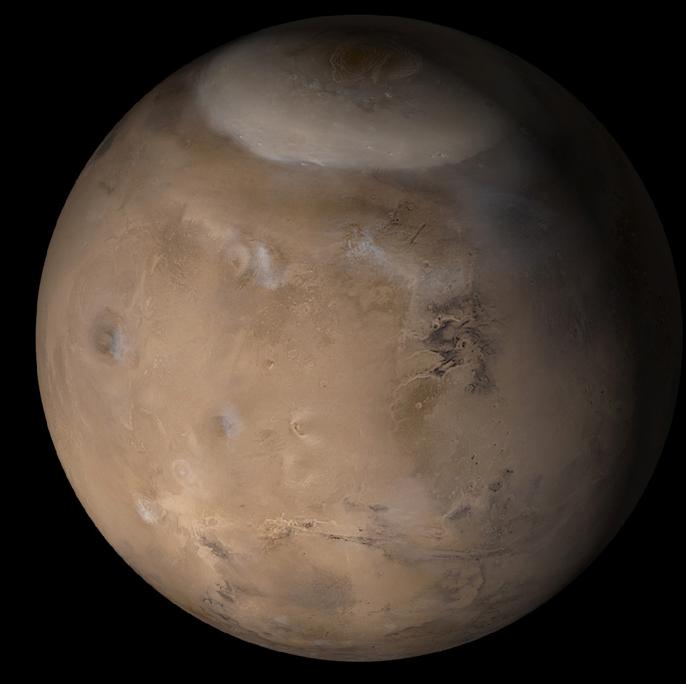
There’s never been much mystery surrounding the murder of Mars. Once a warm, wet world, Mars lost its magnetic field more than 4 billion years ago when its outer core cooled, shutting off the dynamo that kept the field in place. That exposed the planet to the solar wind, which clawed away at the atmosphere; and that in turn allowed the planet’s water to sputter off into space. To look at Mars today is to see a desert world, stamped with the dry riverbeds, delicate deltas and deep ocean basins hinting at the water that is no more.
At least, that’s the long-accepted view. But according to a study published Mar. 16 in Science by a team of researchers at the California Institute of Technology, that scenario might be all wrong. Mars is dry, alright—or at least it appears to be. But the researchers say much of its water—from 30% to a staggering 99% of it—is still there. It simply retreated into the martian rocks and clay rather than escaping into space.
Just how much water once flowed across the surface of Mars is expressed by a unit of measure known as “global equivalent layer” (GEL)—the depth that the water would be if it were not sequestered in basins and rivers, but instead were spread evenly across the entire planet. The best estimates for Mars’s original GEL is anywhere from 100 to 1,500 meters (330 to 4,900 ft). That’s an awfully wide range, but today it’s considerably narrower: the modern-day water on the planet’s surface—almost entirely trapped in its polar ice caps—has a GEL of just 20 to 40 m.
When Mars lost its atmosphere, all that original water had to go somewhere. The evaporation-to-space route was always the easiest explanation—but it’s a flawed one, too. The problem, as the Caltech researchers knew, involves hydrogen. As Martian water molecules rise into and then escape from the atmosphere, they disassociate into free hydrogen and oxygen atoms. An oxygen atom in water is just an oxygen atom, but hydrogen comes in two forms: ordinary hydrogen (with a single proton in its nucleus) and deuterium (with a proton and a neutron). Water molecules made of heavier deuterium instead of ordinary hydrogen are known, straightforwardly enough, as heavy water.
“The vast majority of hydrogen in the universe is just hydrogen,” says Bethany Ehlmann, professor of planetary science at Caltech and a co-author of the paper. “But there’s that tiny fraction that is deuterium. In the Earth’s ocean it’s almost one [heavy water molecule] in a million.”
The greater weight of deuterium causes it to behave differently in the Martian atmosphere. While free hydrogen atoms that were once part of a water molecule escape into space, free deuterium weighs enough to hang around in the air. Over time, as more and more hydrogen drifts away from the planet and more and more deuterium stays behind, the ratio of deuterium to hydrogen (D/H) slowly grows.
“The loss of hydrogen is a sort of constant removal,” says Eva Lingh Scheller, Caltech PhD candidate and the lead author of the paper. “Removing it from the total volume is going to give you a larger D/H ratio.”
But there’s a problem with common measures of Mars’s D/H ratio, Scheller and her colleagues found. Using atmospheric observations by NASA’s MAVEN Mars satellite and the European Space Agency’s Mars Express craft, they concluded that the current ratio is simply too low. If all of Mars’s water had escaped to space, taking its free hydrogen atoms with it, there would be much more deuterium in the modern day Martian sky relative to the remaining free hydrogen—by some measures, more than twice as much. That means that much of the planet’s water never escaped, and the only other place it could have gone was into the soil and rocks—especially into clay, the most abundant mineral on Mars.
“If you suck the water out a different way and let the remainder escape to space, that solves the [D/H] conundrum,” says Ehlmann.
The 30% to 99% range that the researchers posit for the amount of Martian water stored in the ground is admittedly imprecise—and will likely narrow definitively only when humans can collect fresh samples and study them up close. Either way, the fact that the planet may be so heavily hydrated does not, alas, mean much for the possibility of Martian life, since the water molecules are entrained in the rocks and clay, not percolating in free-standing underground pools. Humans explorers, on the other hand, could make use of the hydrated clay—a little.
“You heat your rock to 300º or 400º C and then it would release its water,” says Scheller. “But there’s only a little there so you’d have to cook up a lot of rocks to get any appreciable water.”
Adds Ehlmann: “Water ice is still your best bet.”
Whatever use humans may or may not make of Martian water, the planet clearly has plenty of the stuff. A world we have come to see as entirely barren, is now, we know, at least a little less so.
More Must-Reads from TIME
- Cybersecurity Experts Are Sounding the Alarm on DOGE
- Meet the 2025 Women of the Year
- The Harsh Truth About Disability Inclusion
- Why Do More Young Adults Have Cancer?
- Colman Domingo Leads With Radical Love
- How to Get Better at Doing Things Alone
- Michelle Zauner Stares Down the Darkness
Write to Jeffrey Kluger at jeffrey.kluger@time.com